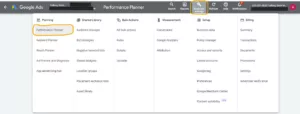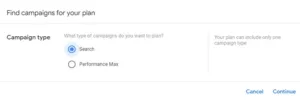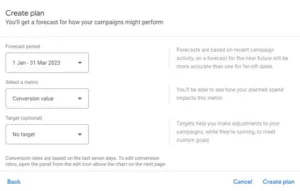Performance Planner – Why Your Business Should Be Using It
Written by Amelia Crisp
So, you have PPC campaigns set up on you or your client’s account…that’s great! But what about keeping track of their current and future performance? Introducing Performance Planner. Customer behaviours and routines are changing more rapidly day in and day out, and this means that we as digital markers need to stay ahead of the curve. Google added this helpful free tool in May 2019 to Google Ads, and if you are not using it yet, we will outline the reasons why you should. But first, let’s explain what Performance Planner is…
What is Performance Planner?
Part of Google’s suite of digital marketing tools, Performance Planner enables you to create detailed plans to forecast outcomes after you implement certain changes, including how this will affect key metrics. There is also a budget section, and the tool recommends spending amounts and opportunities too – all about maxing out that budget. The final plan that is shown can show how much money should be spent to maximise clicks, conversions, or the conversion value. The planner uses search query data and generates ad auctions that have occurred over the last week to 10 days and turns this into insight variables that affect performance by looking at – seasonality, competitor activity, past performance, existing performance, and landing page. In general, with Performance Planner you can:
- Explore outcomes by adjusting campaign settings
- Access forecasts for your campaigns – including their monthly and quarterly performance
- Implement changes that are suggested by your plan quickly and without any hassle
- Understand opportunities in seasonal periods
- Manage budgets across accounts and campaigns
How cool huh? However, bear in mind that this nifty tool has certain requirements, and you can only use it on the following campaign types – Search, Shopping, Display, Video, Local, and Performance Max. To push this further, there are basic criteria that the campaigns must include for it to work:
- They must have received over 3 clicks within the last 7 days
- They must use certain bid strategies
- They must have received 1 conversion within the last week
- They must have run for at least 72 hours
On the flip side of this, you will not be able to use Performance Planner if:
- If you haven’t generated any conversions or clicks
- If your campaigns were deleted
- If your campaigns have a shared budget
- If your ads have been running for less than the allocated 72 hours
Why you should be using Performance Planner
Before we get into the steps of setting up Performance Planner and where to locate it, let’s delve into why your business should be using it. Firstly, the campaign predictions are a life saver. As we all know, implementing a change and knowing how this will plan out Is difficult. For example, when trying out new keywords or targeting, we don’t know if this change will have a negative impact on ad performance, but with Performance Planner we can! The projected performance allows us to see the changes before we add them, ensuring we don’t make any mistakes and keep on track. To push this further, in return, this ensures that the guesswork is taken out of the equation. Instead of guessing what will work and not work, there is now a tool that can do it for you! Secondly, budgets can be maximised with Performance Planner, which means that we can get the most out of our money for our Google Ad Campaigns. This helpful tool can predict how much extra money you will need to spend to adjust your campaigns, as well as if this added cost is worth it in the long run. This also works for decreasing spend. Overall, the proper budget can be set and ensure you get the most out of your PPC campaigns.
How to set up Performance Planner
To make it easier for you, let’s outline a step-by-step process for those who haven’t already used Performance Planner for their own campaigns.
1. Sign into your Google Ads account and select the tools and settings icon that shows in the top bar and click on Performance Planner under the Planning section.

2. This is the area where you can create a new plan or go into your already created plans. Navigate to ‘create new plan’ in blue or click the blue plus button in the left-hand corner.

3. Dependent on which campaigns are available for your account, you may have to choose which campaign type you want to focus on.

4. Now you can choose which campaigns you want in your plan and then click next. Google suggests choosing campaigns with the same goal for better budget management.
5. Select the date range and key performance indicators (KPI’s) such as conversions, clicks, or conversion value. There is also an option to focus on a certain target.

6. Click ‘Create Plan’
7. Once you select this, you will be taken to the draft plan page where you will be able to see an overview of your plan
What is included in the plan?
Forecast Graph
This graph allows you to view how cost changes will affect the performance of your campaign. You can edit the proposed spending by clicking on areas of the graph and in return the forecast will adjust accordingly, allowing you to see the difference between alternative spending amounts.

Separate campaign forecast table
Located under the forecast graph, there is a campaign breakdown table that includes key metric forecasts such as spend, conversions, and average CPA. To push this even further, you can filter this by looking at planned – the campaign’s performance prediction based on the suggested changes, existing – the performance if you don’t implement any changes and carry on with the current campaign settings, and lastly difference or diff. – this reveals the calculated difference between the planned and existing metrics so you can see if adding these changes is worth it in the long run.
Compare
Like the above, the compare section allows you to view a helpful colour-coordinated graph of past performance against planned and existing settings. Some people respond better to visually seeing the impact – it is also a fantastic visual for your client to witness also!

Budget based on data
As we have mentioned previously, the planner allows you to maximise your budget by allocating the best areas to spend your budget on, as well as if said budget is far too high and needs readjusting. It displays the expected performance and results from proposed bidding and budget amounts.
Try it for yourself today!
There’s no time like the present, and we hope this Performance Planner insight has helped you gain a greater understanding of this supportive tool. Guessing the impact of certain changes are long behind us, and now we have the perfect decision-making PPC guide. Struggling with your current campaign performance and need some help and support? Get in touch with our friendly team today – it will be lovely to hear from you!

